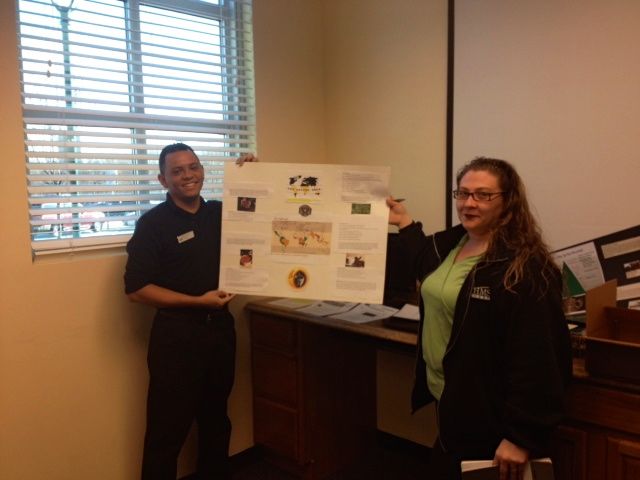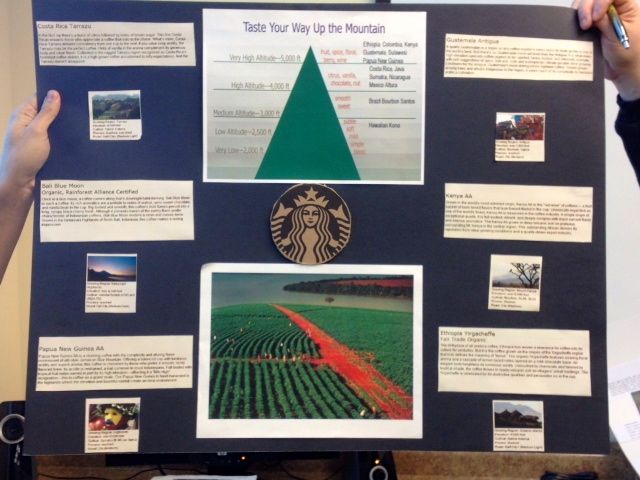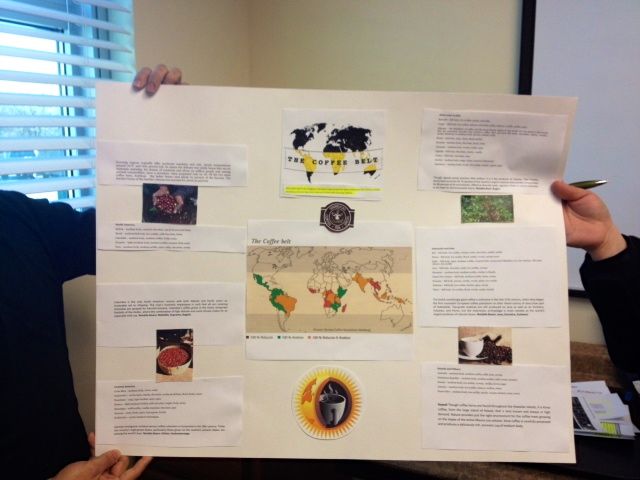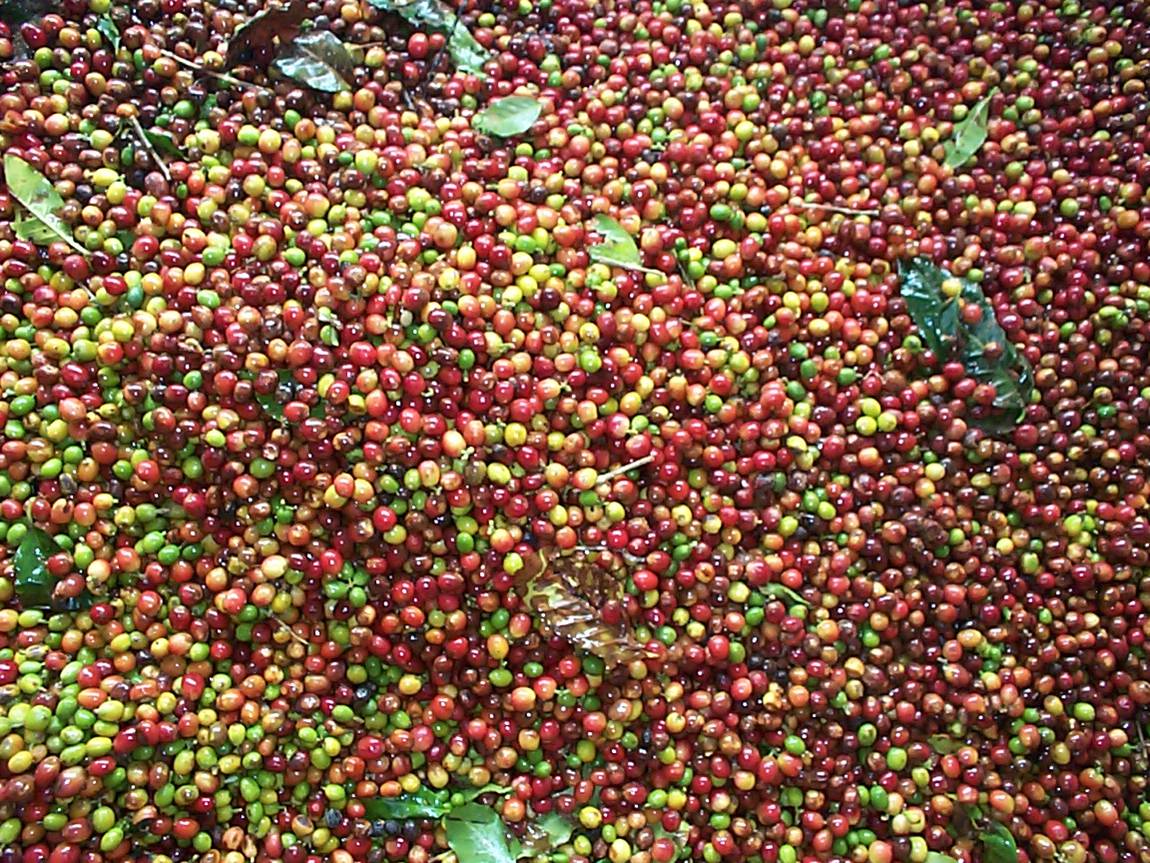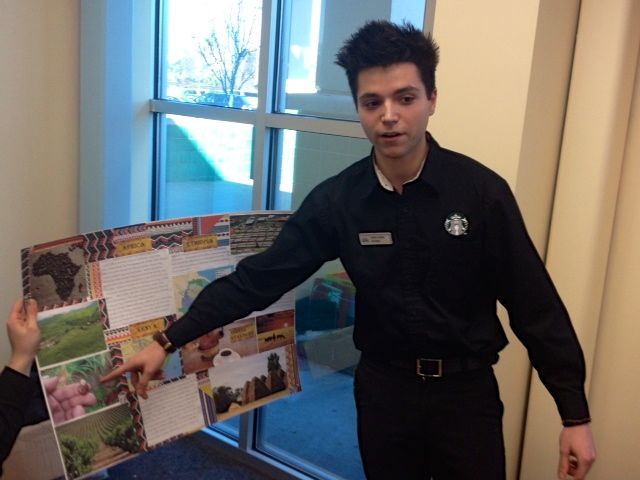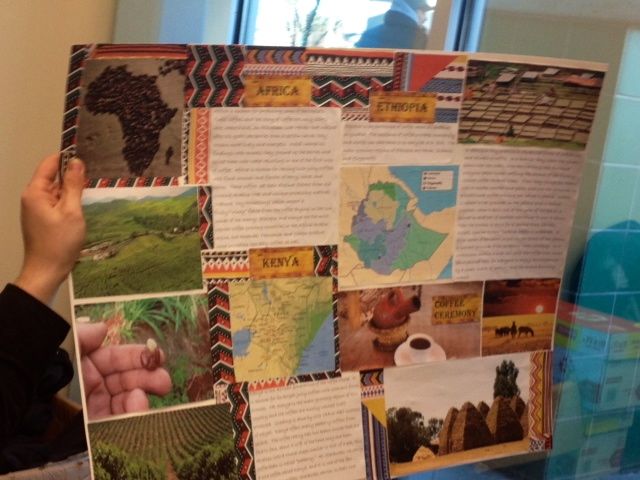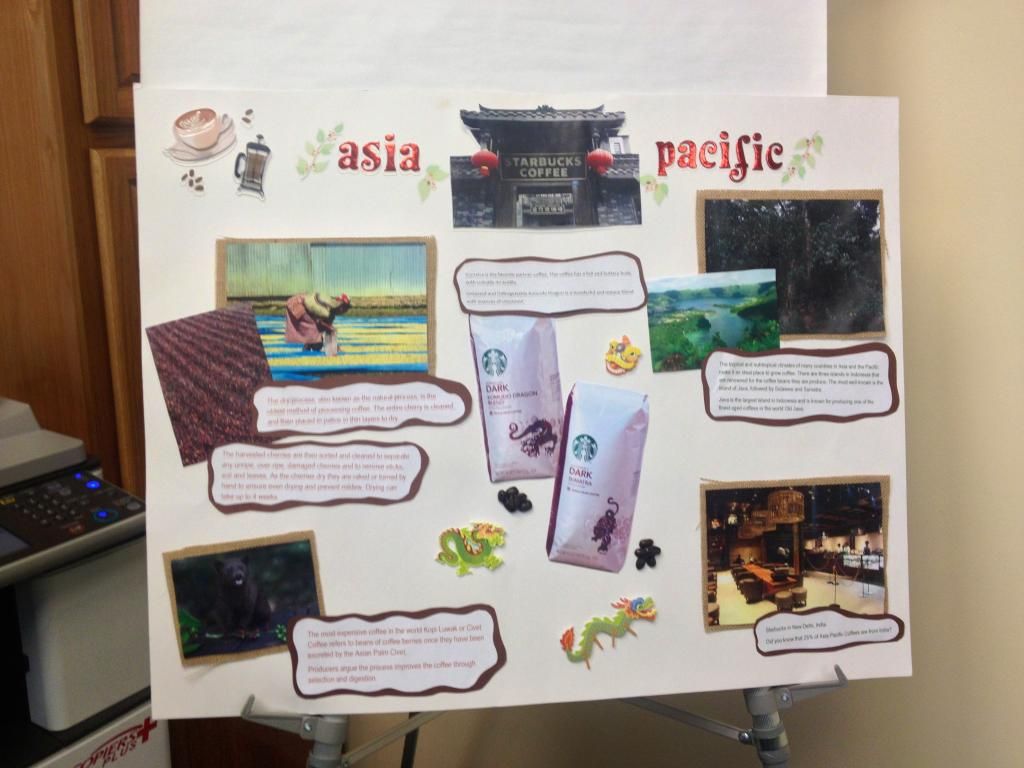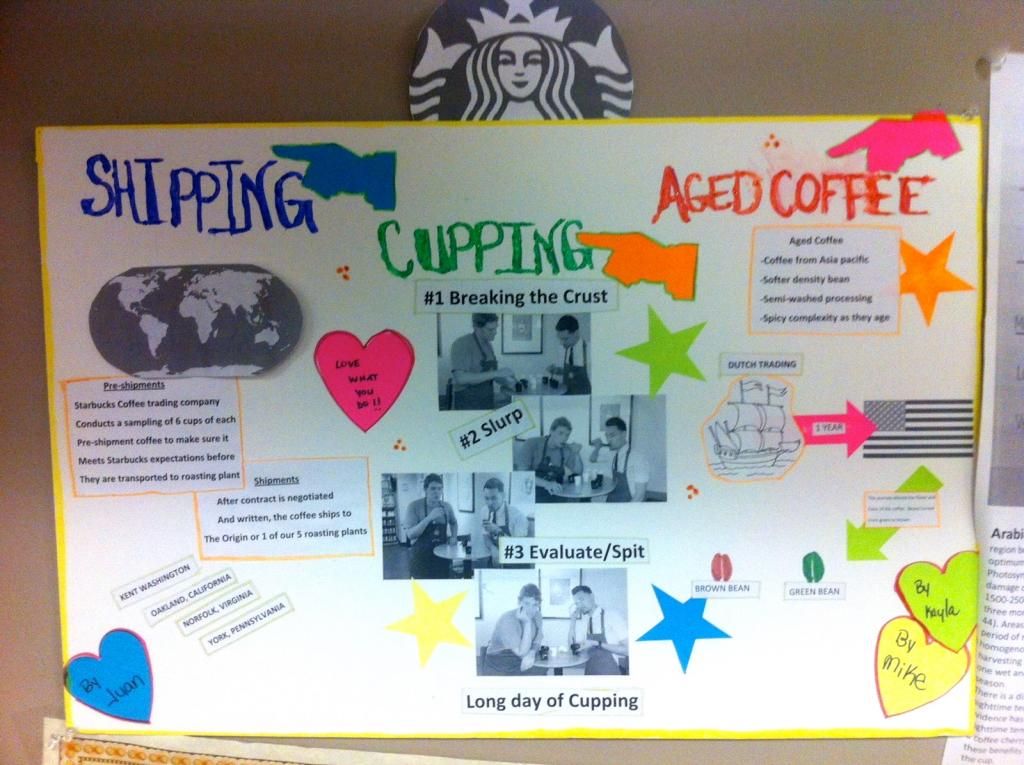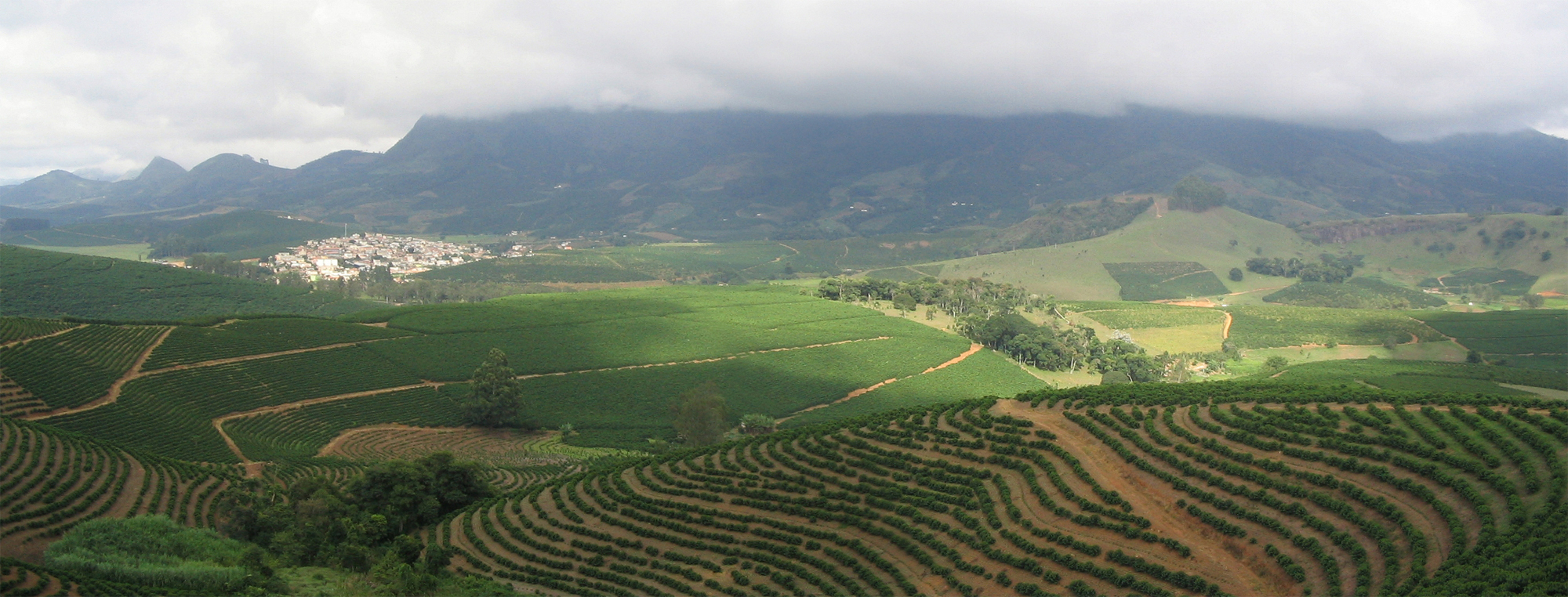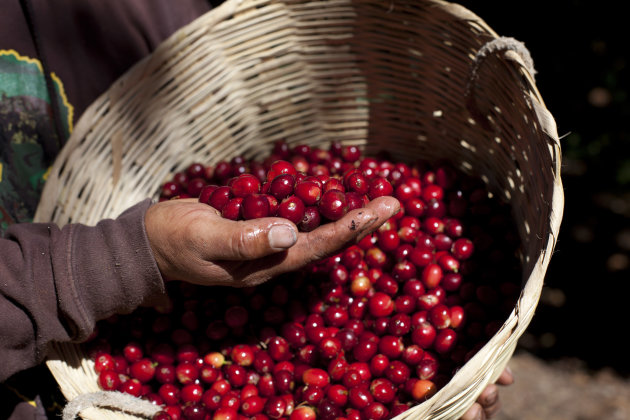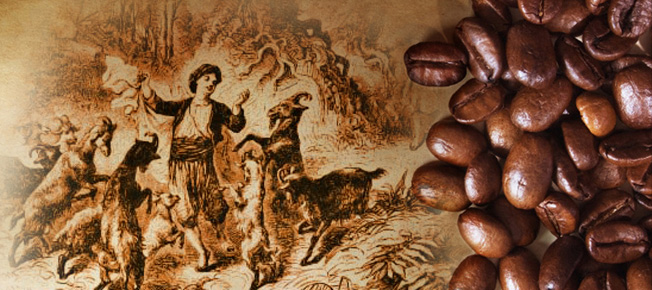Our second Coffee Master Journey meeting was held yesterday at Cheesequake Travel Plaza. Mike Penna (Company Operated Store Manager/Coffee Master from NYC) facilitated the class and brought in samples for us to try of the new cold-pressed juices from Evolution Fresh. Since our last meeting we have been working on our projects and finding coffees to go with each of the subjects in Chapter Two: "Agriculture" of the Coffee Master Journals; Elevation, Latin America, Africa/Arabia, & Asia/Pacific.
(Maykol & Julie presenting their project)
We started out with Maykol & Julie's project which was about Elevation. They made two poster boards with a wealth of great information to share with the class. Showcasing the different elevations that countries grow coffee at and their flavor profile, the "Coffee belt" and even some specific countries that are known for their coffees growing at some of the highest elevations in the world.
(Maykol & Julie's projects)
For their coffee tasting, they chose Starbucks Guatemala Antigua, which is one of the few single origin coffee's in the Starbucks Core Line-up. The coffee had a pleasant aroma with hints of soft spice and cocoa, very balanced yet an elegant complexity. Guatemala Antigua was an excellent choice since the coffee grows at an elevation of 5000-6000+ ft above sea level. The coffee was paired with Caramel Brûlée Bites which brought out the subtle sweetness of the coffee along with it's cocoa notes.
(Latin American coffee ready for washed processing)
The next project was done by Manfred & Roberto on the Latin America coffee growing region and was done as a slideshow presentation. All of the information in the slideshow was extremely informative and detailed along with beautiful scenic pictures of Central America. The project focused around Guatemala and Costa Rica for being important countries to Starbucks coffee buyers. The coffee tasting for this project was Starbucks Puerto Rico which was paired with glazed pomegranate cashews. Coffee was brought to Puerto Rico by Spanish explorers in the mid 1700's and are direct decedents from trees in the groves of King Louis XIV of France. The coffee was balanced and nutty with a soft acidity and a clean finish. The pairing brought out the acidity and complimented the coffee nicely. Mark Ormsbee (Licensed District Manager/Coffee Master) shared pictures of his visit to Costa Rica which summed up a lot of Roberto & Manfred's project with visuals of small family owned farms and stories of Starbucks changing the lives of the Latin American people. "Pura Vida!"
(Jordan presenting the Africa/Arabia project)
(Jay & Jordan's project)
The project on the Africa/Arabia growing region was done by Jay & Jordan. Kenya & Ethiopia were in the spotlight for this project due to how much coffee is produced in these countries and the reception they get for their exquisite and complex taste profiles. Ethiopia is the birthplace of coffee were all arabicas originated and also were some of the first cups of coffee were brewed. The coffees chosen for the tasting were a Starbucks Reserve Malawi: Lake Of Stars which gets it's name from the twinkle of fishermen's lanterns reflecting on the water at night, and a Ethiopia Yirgacheffe from a cafe called America's Cup in Asbury Park, NJ which roasts on site. The Malawi was full bodied with aromas of citrus and soft spice, paired with lemon loaf brought the coffee to the next level. Mike Penna (Company Operated Store Manager/Coffee Master from NYC) commented that the lemon loaf was a excellent pairing for the Malawi and really brought out the citrus flavor in the coffee. The Ethiopia Yirgacheffe was bright with a very noticeable acidity, a light roast comparable to a Starbucks blonde roast with similar attributes. Paired with chocolate cinnamon bread, it brought out the cocoa notes in the coffee while leveling out the acidity and spiciness that the Yirgacheffe region is known for.
(Stacey & Mark's project)
Lastly, Stacey Carpenito (Licensed Brand Champion/Coffee Master) & Mark Ormsbee (Licensed District Manager/Coffee Master) presented their project on the Asia/Pacific growing region. This region is known for producing full bodied coffees that are herbal and earthy with flavors of spice. Sumatra and Komodo are two core Starbucks coffees that come from this region and are very popular amongst the dark roast drinkers. The most expensive coffee, Kopi Luwak, known for it's odd processing method comes from the Asian/Pacific region and could cost up to $300 a pound! The coffee tasting Mark & Stacey provided was a real treat for all of us; the two new Starbucks Reserves West Java Indonesia & Isla Flores Indonesia paired with a variety of cupcakes from Crumbs. The West Java had an herbal complexity with a milk chocolate flavor and paired really well with the red velvet cupcake. The Isla Flores is processed fully washed which is different from most Asian/Pacific coffees which are semi-washed; this coffee was incredibly smooth with a clean finish, and was favored by all in the room.
We are all progressing so well in our Coffee Master Journeys, and yesterday proved it with the amount of information shared and the rising passion for all things coffee.
Thanks to Mike Penna for facilitating this class and bringing in samples of Evolution Fresh!
Thanks to Stacey Carpenito for the Coffee Tasting Guide covers and Starbucks pens!
Thanks to all for bringing in your coffees for us to try and sharing your incredible projects!
The next class will be held at Molly Pitcher Travel Plaza on March 14th at 2pm. I'm sure we're all excited to try some more coffees and share our coffee knowledge to all.
Activity: Comment something that interested you about each of the projects. What was something new that you never knew about for Elevation, Latin America, Africa/Arabia, & Asia/Pacific?
I can't wait to see your responses!
-Jordan

